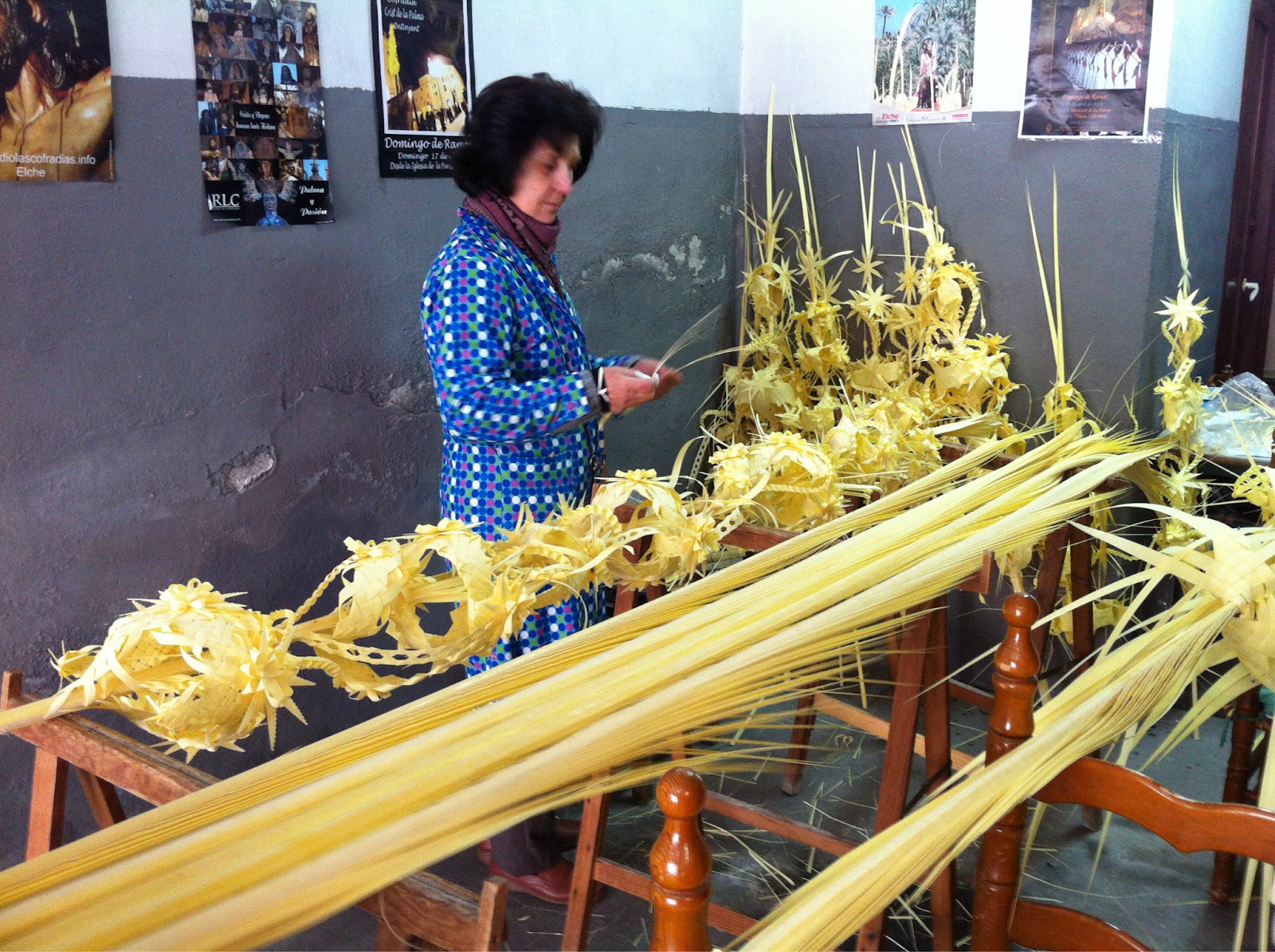This is a little help for my friends from abroad who are interested in getting to know about Elche, Alicante and surroundings, in Southeast Spain.
Translate
Tuesday, 26 March 2013
Thursday, 21 March 2013
Elche White Palm Market
Elche White Palm Market
The tradicional Elche White Palm
Market will take place two days before Palm Sunday (on the 22nd, 23rd,
and 24th March this year 2013). Elche is
famous fot it´s palm trees which provide a large percentage of special blanched
or white palms that are used throughout the world on Palm Sunday.
In many palm groves in and around
Elche, the palm leaves spend most of the year wrapped in black plastic to
starve them of sunlight and turn them from green to golden colour for use in
the parades.
The palm leaves can be used just as
they are cut , or crafted into intrincate designs. You can watch the craft
people at work and buy their beautiful palm products.
This trading takes place in various
city points. The main is in Square Plaza de Baix (beside the City Hall),
and the others are in Plaza de Barcelona, Olaza de Madrid, Mercado del Pla de
San José, Plaza de Castilla Y Plaza de Altabix.
Wednesday, 13 March 2013
ONE OF THE LAST TRADITIONAL OLIVE OIL MILL.
(Updating: the old system in this olive oil mill was changed for modern machinery in 2018)
Around Elche there were about 25 olive oil mills in the middle of the twentieth century. Actually there are 3. One of them is “Almazara Candela”.Today most of the olive oil mills work by centrifugation, with modern automated systems, but this is one of the last that is still working with the traditional extraction system of hydraulic presses.
Around Elche there were about 25 olive oil mills in the middle of the twentieth century. Actually there are 3. One of them is “Almazara Candela”.Today most of the olive oil mills work by centrifugation, with modern automated systems, but this is one of the last that is still working with the traditional extraction system of hydraulic presses.
 |
| Candela´s presses working |
This olive oil mill is situated between olive trees, very near to Elche, 3 minutes by car from General Hospital (Lat. 38°15'3.84"N, Long. 0°39'41.50"O). It´s recommended to study the map before going there. Just before arriving, take as a reference a tall phone mast that is next to the mill. When you arrive you will find an old house, but not a placard of the oil mill.
 |
| Tall phone mast that is next to the mill |
The Almazara Candela began operating in its current location in 1925, with a stone mill pulled by mules and twohand presses. In 1932 the first hydraulic press was installed.
About 80 “capachos” (like a circular carpet made up with polypropylene rope), are put in every press during two hours, and olive oil is separated by decanting of the obtained juice. Once extracted the olive oil, it´s stored in a stainless steel drums. This method is called “first cold pressure”, and many people say that this procedure gives the olive oil a more traditional flavor.
 |
|
Putting crushed mass on the “capachos”.
|
 |
|
“Capachos” in the press and dripping olive oil.
|
Along the year you can buy there virgin olive oil in plastic bottles of 2 or 5 liters. The work season goes from November to January, and then it´s possible to buy unfiltered olive oil, a special choice for olive oil lovers.
UPDATING: in 2018 this olive oil mill changed the traditional system showed in this post, and now is working as others mills with modern equipments.
UPDATING: in 2018 this olive oil mill changed the traditional system showed in this post, and now is working as others mills with modern equipments.
 |
|
Virgin olive oil.
|

Sunday, 3 March 2013
WHITE PALM HANDCRAFT WORKSHOP AND DATES.
 |
| Plaited and smooth palm |
In Plaza Rey Jaime I Square, (Lat. 38°16'6.47"N, Long. 0°41'37.85"O), 4 minutes walking from Elche City Hall, you
can find the Serrano Valero family´s workshop. Between October and Easter, this
family sells here pomegranates and dates of their own plantations, and white
palm handcraft that they make in this place. From Easter to October it´s
closed.
White palm leaves are carried by thousands of people
in the Palm Sunday procession in Elche, through the streets in the city. The first
reference of this tradition was written in 1371.
The production of the white palm leaf (lapel pin, smooth palm and
plaited palm) is a quite laborious process. The plaiting of the white palm is a
task that takes a lot of dedication, and it´s hard to teach.
In worked palms, leaves are
plaited, joint and sewn in order to make decorative motifs like stars, chain
stitches, crosses, virgins, balls, flowers, etc., which are added little by
little to the central palm leaf and thus manage to get beautiful results.
Families of palm farmers like Serrano Valero family, have passed their
artisan knowledge down from generation to generation.
 |
| Fig bread (pan de higo), dates and pomegranates |
 |
| Natural dates |
 |
| Other products for sale |
 |
| Palm-leaf lapel pins |
 |
| Working plaited palm |
 |
| Serrano Valero family, to mid-twentieth century |
 |
| Serrano Valero family´s workshop |
 |
| White palm workshop map |
Subscribe to:
Comments (Atom)


















